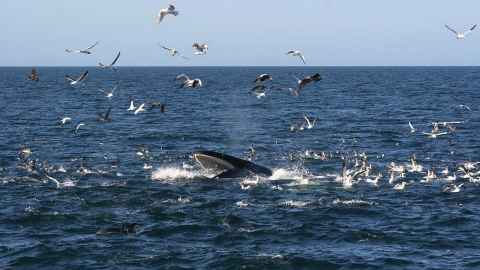Structure and functioning of marine ecosystems
We apply a wide range of approaches in addressing important scientific issues for many marine habitats from estuaries and coasts to the open ocean.

Research topics
Rocky reefs
Rocky reefs are a prominent feature of temperate coastlines worldwide. They support a diverse and highly productive community of animals and seaweeds with important ecological connections to many other habitats. Understanding the structure and functioning of intertidal and subtidal rocky reefs has been a major focus of marine scientists at the University for over half a century. Our current research uses modern techniques to build on their work.
Estuaries and soft-sediment ecosystems
Estuaries and coastal soft-sediment are hotspots for ecosystem functions and services. Our research explores how these ecosystems function at multiple scales from sediment biogeochemical processes to ecosystem connectivity and habitat restoration.
Sensory ecology and acoustics
Marine animals use a suite of sensory systems to communicate and navigate through the ocean. Our focus on acoustic ecology seeks to understand the role that underwater sound has on the life-history strategies of marine animals. We also consider the impact of human-made sound, which may mask or disrupt these acoustically mediated strategies.
Marine megafauna
Marine megafauna are often apex predators, with a significant influence on ecosystems and associated species. Our research operates both within north-eastern New Zealand and beyond. We take a highly integrative approach, seeking to understand how megafauna respond to biotic and abiotic influences through time and space.
Larval recruitment
Larval processes are crucial to the organisation and operating of all marine ecosystems. Despite their importance, they are surprisingly poorly understood. Our research aims at improving knowledge of the biology of larval stages and recruitment.
Genetic connectivity
Gene flow connections mediate the stability, interdependence and diversity of marine communities. Our research seeks to improve understanding of where, when and to what degree this genetic connectivity between populations and communities occurs. In turn, we aim to discover how such biodiversity arose and is maintained.
Open ocean processes
Our research monitors and models physical ocean circulation, the abundance and distribution of marine organisms, and the chemical elements necessary for life in our oceans. It includes a significant citizen science programme that aims to document the diversity of life in open oceans.
Related research centres
George Mason Centre for the Natural Environment
Joint Graduate School in Coastal and Marine Science
Cawthron Institute
Our researchers
Dr Caitlin Blain
- Rocky reef ecology
Professor Rochelle Constantine
- Marine megafauna
Dr Alice Della Penna
- Open ocean processes
Dr Brendon Dunphy
- Marine megafauna
Dr Rebecca Gladstone-Gallagher
- Estuaries and soft-sediment ecosystems
Dr Jen Hillman
- Estuaries and soft-sediment ecosystems
Professor Andrew Jeffs
- Acoustics and sensory ecology
- Open ocean processes
- Larval recruitment
Associate Professor Shane Lavery
- Genetic connectivity
Associate Professor Carolyn Lundquist
- Estuaries and soft-sediment ecosystems
- Larval recruitment
- Sensory ecology and acoustics
- Marine megafauna
Associate Professor Xavier Pochon
- Open ocean processes
Associate Professor Craig Radford
- Sensory ecology and acoustics
- Marine megafauna
Associate Professor Nick Shears
- Rocky reef ecology
Associate Professor Richard Taylor
- Rocky reef ecology
Professor Simon Thrush
- Estuaries and soft-sediment ecosystems